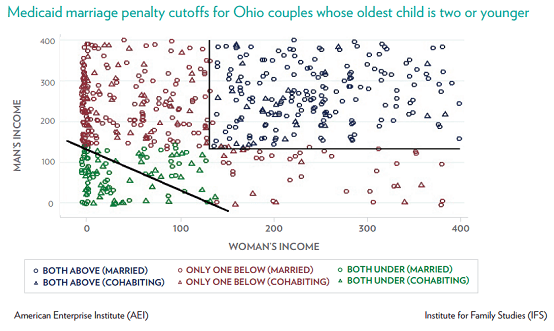The Safety Net vs. Marriage

Today the American Enterprise Institute and the Institute for Family Studies have a big new report about how poverty-relief programs punish people for getting married. You can read it here, but in this post I’ll highlight a few findings that stand out to me.
Full disclosure: I’m a regular contributor to Family Studies, a website run by IFS and overseen by W. Bradford Wilcox, one of the study’s authors.
A “marriage penalty” occurs when a couple will get less in poverty benefits if they marry than if they don’t. This chart, using data from Ohio and the benefit cutoffs from the state’s Medicaid program, nicely illustrates the phenomenon once you take a minute to digest it. The income figures are percentages of the poverty line, not dollar amounts, and the couples between the two black lines face a marriage penalty—at least one member is eligible for benefits alone but not once the other member’s income is added.
In the lower left are couples that will be eligible for Medicaid whether they marry or not, because both members of the couple have low incomes. In the upper-right are those who can’t get Medicaid no matter what. And along the left-hand border are couples where the woman has no income but the man works—these are largely stay-at-home moms, so they’re tough to categorize. (Stay-at-home spouses would be eligible for safety-net programs according to their individual income, but they can’t meet the work requirements of the programs that have them, including cash welfare and food stamps.)
But there’s also a vast sea of income combinations where the safety net imposes a marriage penalty. The authors report that, nationwide, marriage penalties are most common between the 20th and 60th income percentiles, basically the working and middle classes. In this range, more than 80 percent of couples with children under two face at least one marriage penalty from the Medicaid, cash-welfare, and food-stamp programs, though this too includes couples where one parent stays home by choice. (By the same measure, about a quarter of couples in the top 20 percent also face a penalty, which the authors note is “not particularly relevant.”)
This is a clear fairness issue, and it also might have bad practical consequences. In one survey, nearly a third of Americans said they personally knew someone who decided not to get married to avoid losing benefits. The authors also conduct a statistical analysis with interesting results—“marriage penalties are most salient in shaping the marriage decisions of lower-middle-class couples with new children who are participating in Medicaid and food stamps,” they write.
But as the sociologist Kathryn Edin noted at an event celebrating the paper’s release earlier today, the effects are rather small, a reduction of a few percentage points in the chance of being married. Maximizing welfare benefits is, to put it mildly, not the only factor people consider when they decide whether to tie the knot.
I’ll leave you with the authors’ four suggestions for fixing the problem:
1. In determining eligibility for Medicaid and food stamps, increase the income threshold for married couples with children under five to twice what it is for a single parent with children under five. Such a move would ensure that couples just starting a family do not feel pressured to forgo marriage just to access medical care and food for their families. The cost of this policy change would be limited, since it would only affect families with young children.
2. Offer an annual, refundable tax credit to married couples with children under five that would compensate them for any loss in means-tested benefits associated with marrying, up to $1000. This would send a clear signal that the government does not wish to devalue marriage and, for couples, it would help to offset any penalties associated with tying the knot.
3. Work with states to run local experiments designed to eliminate the marriage penalty associated with means-tested policies. States could receive waivers to test a range of strategies to eliminate penalties in certain communities, and to communicate to the public that the penalties are no longer in force there. Successful experiments could then be scaled up to the national level in future efforts to reform means-tested policies.
4. Encourage states and caseworkers working with lower-income families to treat two-parent families in much the same way as they do single-parent families. For instance, states could ease the distinctive work requirements that many have in place for two-parent families receiving cash welfare. Reforms such as this one would put two-parent and single-parent families on a more equal footing when it comes to public assistance. More generally, policymakers and caseworkers should try to eliminate policies and practices that effectively discriminate in favor of single-parent families.
Robert VerBruggen is managing editor of The American Conservative. Follow @RAVerBruggen

Comments